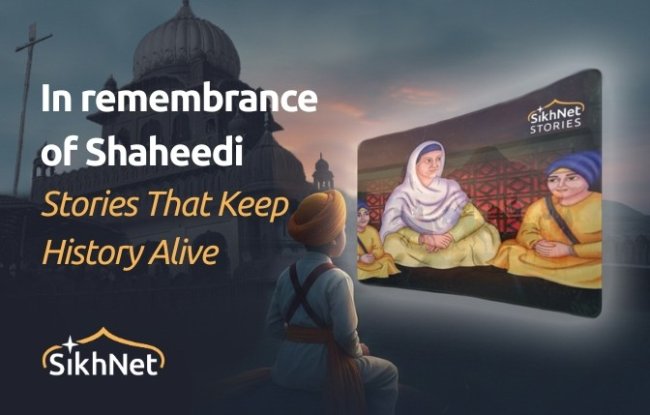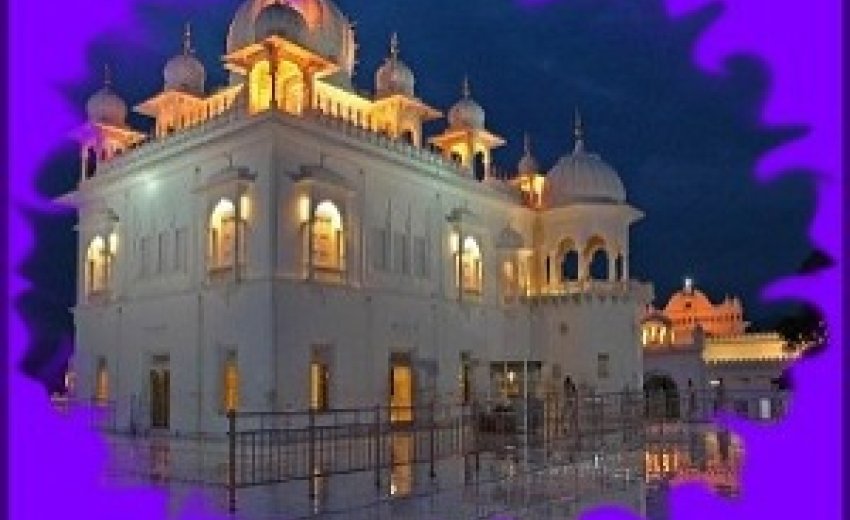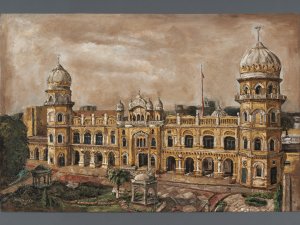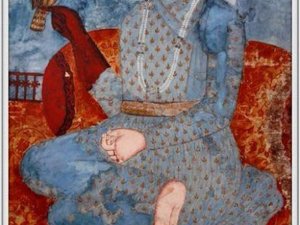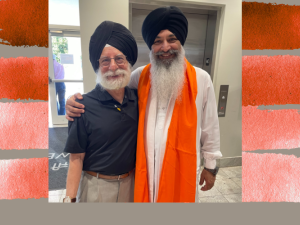If we look back into the past, since the time of advent of Guru Nanak Dev Ji, we can see that a very significant history has been created. Unfortunately, we do not even see a speck of that history in the so called history books when history is supposed to be a record of the past. However, if we look closely at the month of December, in 1704 AD we will find that a plethora of significant events took place; these were not just significant historical events related to Gurus and the Sikhs, but these were events that turned the course of history. It is for this reason that it is being proposed that the month of December be celebrated as the Sikh Heritage Month, so that we can develop understanding of the world of the times. First, let us first look at these events in brief.
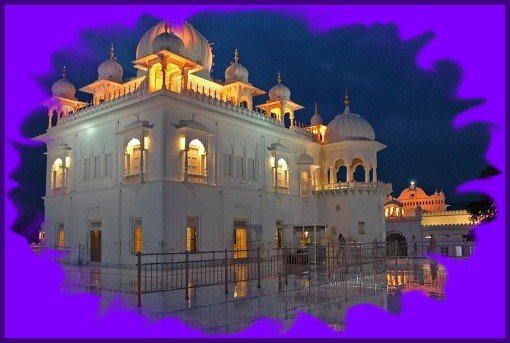 20 December 1704: The Mughal army along with the armies of Hill Rajas had laid a siege on Anandpur Sahib Fort since 3 May 1704. All the supplies coming to the fort were cut off, and the seven month long siege had depleted all the resources inside the fort, and there was nothing left in the fort to eat. Because of the long siege all the besieged inside including Guru Gobind Singh Ji and his family members were put to severe hardships. In addition, hunger, thirst, scarcity of supplies, restriction on movements had taken their toll as well, yet Guru Ji was in a firm and high spirits. It was the hardship and the hopeless situation that made the forty Sikhs sign the "Disclaimer" that we are not Sikhs and walk out of the fort, unharmed by the forces that laid the siege. Although, Guru Ji was being pressured by the exhausted Sikhs to take on the promise of safe passage and evacuate from the fort, but Guru Ji said that their intentions were not sincere and they could not be trusted. Finally, at the behest of famished Sikhs and mother of Guru Ji Mata Gujri Ji it was agreed that the fort will be evacuated, although Guru Ji was still not in favor. On this fateful night of 20 December the fort was evacuated at night. The mid-winter night was dark and bitterly cold, and now on top of that it began to rain heavily. The unfavorable weather and the flooded River Sirsa in full spate, did make the task of evacuation formidable. Now, on top of this forces that had laid the siege forgetting their promises of safe passage, pounded on the Sikhs and very heavy fighting took place.
20 December 1704: The Mughal army along with the armies of Hill Rajas had laid a siege on Anandpur Sahib Fort since 3 May 1704. All the supplies coming to the fort were cut off, and the seven month long siege had depleted all the resources inside the fort, and there was nothing left in the fort to eat. Because of the long siege all the besieged inside including Guru Gobind Singh Ji and his family members were put to severe hardships. In addition, hunger, thirst, scarcity of supplies, restriction on movements had taken their toll as well, yet Guru Ji was in a firm and high spirits. It was the hardship and the hopeless situation that made the forty Sikhs sign the "Disclaimer" that we are not Sikhs and walk out of the fort, unharmed by the forces that laid the siege. Although, Guru Ji was being pressured by the exhausted Sikhs to take on the promise of safe passage and evacuate from the fort, but Guru Ji said that their intentions were not sincere and they could not be trusted. Finally, at the behest of famished Sikhs and mother of Guru Ji Mata Gujri Ji it was agreed that the fort will be evacuated, although Guru Ji was still not in favor. On this fateful night of 20 December the fort was evacuated at night. The mid-winter night was dark and bitterly cold, and now on top of that it began to rain heavily. The unfavorable weather and the flooded River Sirsa in full spate, did make the task of evacuation formidable. Now, on top of this forces that had laid the siege forgetting their promises of safe passage, pounded on the Sikhs and very heavy fighting took place.
21 December 1704: It was early morning now. Most of the fighting had died, still the bullets, arrows were flying and rain was falling but Guru Ji did not deviate from the daily morning ceremony of singing of Assa De Waar. So, Guru Ji held a diwan in open on the banks of the River Sirsa. After the conclusion, the prayers were offered and Guru Ji asked to prepare for crossing the River Sirsa. Guru Ji had just crossed the swollen river and other Sikhs were in the midst of crossing the river, when a contingent of the Mughal army arrived. Bhai Udhe Singh the commander of Guru Ji's forces who was guarding the rear end of the column, single-handed resisted the chasing Mughal army, so that others could cross the swollen river. Bhai Udhe Singh displayed exemplary bravery there and laid down his life but in the process saved many lives. Even Sahibzada Ajit Singh, the eldest son of Guru Ji got surrounded by a contingent of Mughal Army and put on very brave fight. Bhai Jeewan Singh saw that Sahibzada Ajit Singh is surrounded and he came charging with his spear and provided cover for Sahibzada and urged him to get out. Bhai Jeewan Singh single handed held the advancing forces for long time to allow remaining Sikhs and Sahibzada to cross the river. He also laid down his life there. Besides these two stalwarts many other Sikhs also gave their lives there. Even today the memorial at the site on the banks of River Sirsa is visited upon by devotees to pay their respects.
It is here only that that Mata Gujri Ji, the aged mother of Guru Gobind Singh with her two little grandsons got separated from the main party and escaped in one direction. They kept moving so that they could escape from the harm's way and by chance they met Gangu who was cook in Guru Ji's household. He took them to his village Kheri promising shelter but in the morning turned them over to the officials of Nawab of Sirhind. The second separated party consisting of Guru Ji's wife Mata Sundri and Mata Sahib Kaur along with Bhai Mani Singh who was acting as their escort stayed at the house of a trusted Sikh in Ropar and from there they proceeded to Delhi.
Guru Gobind Singh Ji accompanied by his two older sons and a group of forty survivors marched towards Ropar via Kiratpur and Nirmohgarh. There the village people refused to offer shelter for fear retribution and directed them to a brick kiln. There Guru Ji decided to camp for the night. However, a landlord farmer Chaudhri Budhe Chand of Chamkaur offered his haveli (type of house in a shape of fortess) to Guru Ji as that will provide some shelter, cover and protection against the chasing armies of ten thousand. By night time the marauding Imperial forces also reached Chamkaur and had surrounded this mud house designed like a fort.
22 December 1704: Next day, early morning of 22 December the Imperial army attacked with the aim of capturing the fortress and Guru Ji. There, Guru Ji assigned eight of his Sikh soldiers each in a party of two to guard the entrance and the four walls. Guru Ji situated himself on the upper floor and from there not strategically directed his Sikh soldiers but also kept an incessant shower of arrows. Thus from the vantage position Guru Ji not only commandeered the fight but also with his arrows complemented the ground forces resisting the advancing armies. The general of the Mughal army Nahar Khan and Ghairat Khan tried to scale the wall with the help of a ladder but were shot down in timely manner by Guru Ji with an arrow. The death of the leader quite demoralized the attacking forces. Now, Nawab of Sirhind took the lead and asked his forces to make the final charge. Both the elder sons of Guru Gobind Singh Ji and three of five Punj Pyares, and thirty of the Sikhs gave their lives there defending the haveli.
Only five Sikhs were left to defend the place. They persuaded Guru Ji to retreat and save himself in the larger interest of the nation, so that Guru Ji can still carry on the mission and create new bands of Khalsa. This was done by the remaining five Sikhs in form of a "Gurmatta" (a unanimous resolution) and Guru Ji bowed to the mandate of the supreme authority of Khalsa Brotherhood. So, under the thick cover of night, Guru Ji left the haveli with three of his disciples Bhai Daya Singh, Bhai Dharam Singh and Bhai Man Singh. The remaining two Bhai Sant Singh and Bhai Sangat Singh were assigned the duty of defending the haveli. Bhai Sangat Singh was dressed with clothes of Guru Ji, given Guru Ji's plume and gold tipped arrows so that the besieging armies may be deceived into believing that Guru Ji is still in the haveli because of his resemblance with Guru Ji. Even when Guru Ji was forced to retreat he blew the bugle and announced thrice and then other Sikhs kept on repeating the same words:
"Peerae Hind may ravad."
Meaning: The sage of India has escaped.
Before making the escape Guru Ji discharged arrows in different directions from his bow causing great confusion in the midst of pitch darkness of the night. The three Sikhs accompanying Guru Ji could not keep pace with Guru Ji and in the darkness got separated from him. Guru Ji lonely, fatigued, barefooted, with his clothes in tatters trudged along the thorny wilds of Machhiwara and arrived in a garden.
Based on the Gregorian calendar this is the of Parkash Ustav (birthday in pure human terms) of Guru Ji, but on this day Guru Ji is all alone, yet his celebration is of high spirits, where hunger, thirst, exhaustion from wars, lack of warm clothes, bed, shelter or shoes in biting winter cold does not dampen the spirit.
For days he found neither food nor shelter. His feet were blistered and bleeding. He slept in the woods with an earthen pot as his pillow and open sky as his quilt in the winter nights. But his spirit was undaunted, neither his noble resolve nor his patriotic fervor ever flickered. The super resolve of his spirit is enshrined in his own words as his poetic composition which he sang there is:
"imqR ipAwry nMU hwl murIdW dw kihxw ] quDu ibnu rogu rjweIAW dw EFx nwg invwsW dy rihxw ]"
"Mitar piyarae noo haal mureeda da kahinna. Tudh bin rog rajaaian daa odhan, naad nivaassa dae rahinaa."(Shabad Hazare)
Meaning: Convey to our dear Friend (God) the news of His disciples. Without You, the warmth of comforters (quilts) is like a disease. Living in palace is like living amongst snakes.
We are not discussing the whole composition here, except to point out according to Guru Ji the futilities of life of luxuries, if the remembrance of God is missing. The story of his wandering is not just a romance of hair breath escapes, but also celebration of great valor, firm and noble resolve not to surrender, and full faith in the Creator. After three days the three separated Sikhs rejoined the master. The saga of history continued to be created by Guru Ji, as he moved to Hehar, on to Jatpura, and then on to Raikot. It is at Raikot Guru Ji learnt about the fate of his mother and two younger sons, which we will explore now.
23 - 27 December 1704: Now, let us look at the fate of Mata Gujari Ji and two younger Sahibjadas. On 23 December the two younger Sahibzadas Zorawar Singh and Fateh Singh aged nine and seven years were produced in the court of Nawab Wazir Khan of Sirhind. There, they were enticed to change their faith with promises of positions in kingdom and marriages into the royalty. When the persuasions and temptations failed to produce the desired results the ruler resorted to threats, torture including deprivation of food and sleep. For four cold winter nights they were forced to spend in an airy tower to weaken their spirits and resolve. On 27 December a council of ministers were called upon to consider ways and means to bring the princes into the fold of Islam. The princes were brought to the court and an inevitable choice of death or acceptance of Islam was offered to them. The princes, true to their faith, preferred death over conversion. At that time, Diwan Sucha Nand rose from his chair and walked closer to two princes and asked them if they were released what will they do? Their reply was that we will go to jungles and raise army of Sikhs, procure horses, arms so that we can fight the oppression. They further reminded Sucha Nand about their heritage in these words:
"Humrae bans reet im aa-ee. Seeas daet dharma na jaa-ee."
Meaning: In our family the tradition is to give (our) head but not give up our faith.
The reply infuriated Diwan Sucha Nand and he counseled the Nawab; "Sir, this progeny of a cobra had better be smothered in time." A very cruel form of execution was devised. The Sahibzadas were bricked alive, and when they fainted out of suffocation, they were beheaded. The grandmother Mata Gujari expired in the prison on hearing about the tragic end of her two beloved little grandsons. This tragic event took place on 27 December 1704. It was at Raikot that Guru Ji heard about the entire episode from the messenger Mahi, who was deputed to Sirhind to get first hand information.
Even after learning about the brave deaths of his remaining two younger sons, Guru Ji spirit was still high and his statement; "What if I have lost four sons, but countless more alive." is a testimonial to his ever high spirits. Guru Ji declared they have not died, but have become immortal. They have lifted the downtrodden and shown the way to liberty. Guru Ji declared that the rule of Mughals has been uprooted. The colorful history continued to be created but let us stop here as continuing it will be pushing us to the month of January 1705 AD.
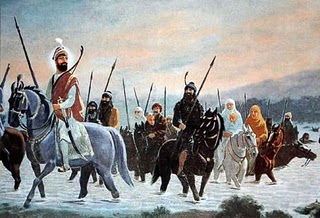 So, if we make December as The Sikh Heritage Month it will be chronologically ensconced between two major Parkash Gurpurabs celebration of the founding Sikh Guru Nanak Dev Ji and the last Guru, Guru Gobind Singh as they are celebrated according to Sikh Calendar. This month will be celebrated as the heritage of the two hundred thirty years of the legacy that the ten Gurus, Sahibzades and Sikhs of the period created. By celebrating it as The Sikh Heritage Month we will not be just celebrating significant chapters of the history but will be drawing fresh blood and inspiration from it. Times have changed, life styles have changed, and technology has skewed our perception of history, including its significance and relevance. But by designating it as Heritage Month we will not just be acknowledging that history matters, but simultaneously reaffirming our relationship with the past and its inspiration for the future. History not saved is not just lost, but along with it, its potential for future guidance is lost as well. History is not just a record of an event in the past; but it has a potential to passionately fire the nation and inspire it, provide a new turn, a turn that can change the course of history. The significance of history has been described by Guru Amar Das Ji as:
So, if we make December as The Sikh Heritage Month it will be chronologically ensconced between two major Parkash Gurpurabs celebration of the founding Sikh Guru Nanak Dev Ji and the last Guru, Guru Gobind Singh as they are celebrated according to Sikh Calendar. This month will be celebrated as the heritage of the two hundred thirty years of the legacy that the ten Gurus, Sahibzades and Sikhs of the period created. By celebrating it as The Sikh Heritage Month we will not be just celebrating significant chapters of the history but will be drawing fresh blood and inspiration from it. Times have changed, life styles have changed, and technology has skewed our perception of history, including its significance and relevance. But by designating it as Heritage Month we will not just be acknowledging that history matters, but simultaneously reaffirming our relationship with the past and its inspiration for the future. History not saved is not just lost, but along with it, its potential for future guidance is lost as well. History is not just a record of an event in the past; but it has a potential to passionately fire the nation and inspire it, provide a new turn, a turn that can change the course of history. The significance of history has been described by Guru Amar Das Ji as:
"bwbwxIAw khwxIAw puq spuq kryin ] ij siqgur BwvY su mMin lYin syeI krm kryin ]"
"Baabaaneeaa kahaaneeaa puth saputh karaen. Jae satgur bhaavai s mun lain saeee karam karaen".(SGGS, Pg. No. 951)
Meaning: The stories of one's ancestors make the children, good children. They accept what is pleasing to the Will of the True Guru, and then act accordingly.
Unfortunately if we look at this wondrous history, we will find that we did not even create an authentic historical record. Whatever records that exist, were prepared by men of letters who were employed by the rulers against whom the struggle was waged. The result is a tainted, skewed, and biased history that has been painted through their pen to appease their masters and to lead credence to their own viewpoint. The more serious crime we have inflicted upon ourselves in our zeal to create memorials at the sites where history was created, by our failure to preserve those places in their original state. We have talked about two events in Chamkaur and Sarhind but if we visit these places we will find that the historical evidence has been destroyed for ever. We cannot find the walls of haveli in Chamkaur nor can we find the bricks or the walls where younger Sahibzadas were bricked alive. Those relics would have given us an appreciation of the courage displayed when horror and atrocities were committed against them. Thus those relics like an ublical cord connected us back to the times as it was happening right in front of our eyes. The words that Allahyaar Khan Jogee has penned about Chamkaur are worth remembering:
"Bus aik Hind mae teerth hai yatra kae lee-ae. Kataa-ae bap nae bachae jahan khudaa kae lee-ae. Chamak hai mehar kee chamkaur tare jaroe mai."
Meaning: There is just one place of pilgrimage in Hind (India) that is worth a visit. Where, a father gave his (two) sons for cutting (to pieces in the battlefield) for God's sake. There is a (certain) glow of grace, Chamkaur in your roots.
Alas, we have failed to preserve this beautiful place of pilgrimage in its pristine state. The experience and feel of ground reality of times have a different emotional appeal and it can weave its magic in such a way that it can transport us back to the times of creation of that history. Where, the stimulated mental imagery could provide us with a feel of being a witness to the history, and also emotionally stirring us in such a fashion that we could feel that we are in the midst of it. The shrines of marble and gold cannot capture the nostalgia, emotional appeal that could be experienced otherwise. In fact we have robbed the future generations from this historical evidence. Now, whatever is lost cannot be restored back to its original condition, but it can provide us with new understanding to preserve the sites in their original state.
The courage that was displayed during the period of 1704 AD inspired the whole nation then, but its potential to inspire today and in future is still undiminished, in any way. It still has the same charisma to inspire but we need to first appraise ourselves with it, share it with others and galvanize ourselves to our highest potential in commitment to faith, courage, bravery, and firmness in adversarial situation.
The existing disconnection from the golden heritage is producing exactly the opposite impact today then it did at that time. So, it is time we change the way we commemorate these events now. At present these historical occasions are celebrated as Jor Melas at Chamkaur Sahib and Fatehgarh Sahib. But it is time to elevate these celebrations to a worldwide scale by taking the events to world, as it is not possible for everyone to come for the Jor Melas. Instead of celebrating these occasions with parade and day long events, let us celebrate them by sharing these golden pages of history with young children. The history can be shared by employing modern methods of presentation as Power Point and DVDs. In addition there could be touring exhibition bus which makes stop at all schools and share with the history and inspire future generations. In addition competition for school going children can be organized and the selected winners can be taken to a tour of these historical places. These visits will be life-changing experience for these youngsters, and then in turn they can inspire and motivate others. Let us rehear the reverberation of the popular sayings of those times again:
"Katvaa ke sar char ik aasoona na giraaya. Rooh phook de Gobind ne, aulaad kataa kar."
Meaning: (Although he) Got the heads of (his) four (sons) beheaded, (still) did not shed a drop of tear. By getting his progeny beheaded Gobind breathed a new life (in the people).
We can look at the Jewish people to learn from them how to preserve and share history. We can see how they have preserved the Wailing Wall of Jerusalem from the times of King Solomon for thousands of years. In modern times they have preserved the relics associated with the holocaust. They have set up Holocaust Museums, travelling exhibitions, and made that history known to the world. Today we hear that that the younger generation is distant and disconnected from their faith. Let us reach to them, share with them the history in the way they get information in educational system of today. This connection, sense of belonging will inspire them with the ideals of our Guru Sahibs. We can make it happen and the commemoration this way will be inspiration for our coming generations as it can fire them with the same determination and courage that was exemplary of the four Sahibzadas. If we can relate to the pain, suffering, courage, valor and faith displayed during that tumultuous period, then that bonding will strengthen us today and will help us make tomorrow stronger.
References:
1. Singh, Teja and Singh Ganda. A Short History of the Sikhs (Volume 1). Publications Bureau. Punjabi University, Patiala.
2. Singh, Puran. The Book of the Ten Masters. Singh Bros. Amritsar.
3. Mansukhani, G. S. Hymns from the Dasam Granth. Hemkunt Press. New Delhi 110028.
4. Singh, Bhai Vir. Shri Kalgdhar Chamatkar(Uttraradh) - In Punjabi. Bhai Vir Sigh Sahit Sadan, New Delhi.
5. Singh, Prof. Jagdeesh Singh. Nikeean Jindan Vaada Saaka. SGPC, Amritsar.
6. Singh, Prof. Jagdeesh Singh. Saaka Chamkaur. SGPC, Amritsar.
7. Singh, Prin. Satbir Singh. Jangaa Gur Patsaahan Deean. SGPC, Amritsar.
8. Singh, Prof. Kartar Singh. Life of Guru Gobind Singh. Lahore Book Shop, Ludhiana.
